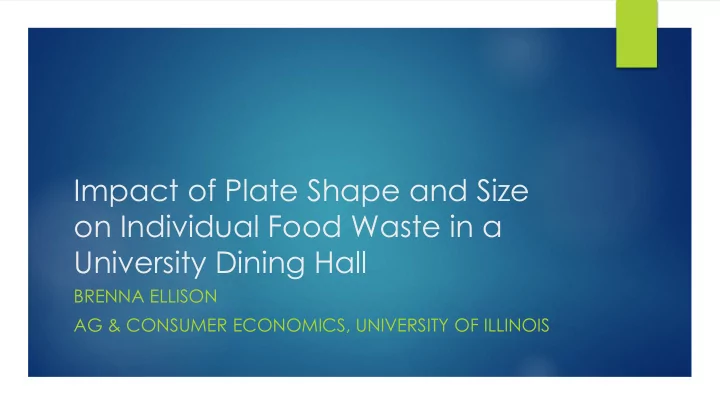

Impact of Plate Shape and Size on Individual Food Waste in a University Dining Hall BRENNA ELLISON AG & CONSUMER ECONOMICS, UNIVERSITY OF ILLINOIS
Research Team Rachel Richardson, MS (thesis research topic) Melissa Pflugh Prescott, Assistant Professor in Food Science & Human Nutrition Approximately 15 Undergrad/Grad Research Assistants BIG THANK YOU to: University of Illinois Dining Services Administration and Staff
History of Collaboration with Dining Services Shared interest in reducing food waste 1 st study: Impact of educational campaign Results in right direction, but impact was modest
If education did not work, what are our options? Change the message Suggestion: Help students visualize the amount of waste Suggestion: Peer-to-peer education Change the dining environment Option: Move to a la carte pricing Option: Reduce amount of self-service options Option: Change dishware/servingware
Latest Study: Changing Plate Size/Shape to Reduce Waste Traditional Round Plates vs. Smaller Oval Platters Intuition: Smaller surface area reduces the amount of foods students take and waste Research supports this intuition, but no work in university AYCTE setting
How did we study this? Worked with two dining halls in Fall, 2018 Ikenberry (IKE) Pennsylvania Avenue (PAR) Used a crossover design where we tested both round plates and oval platters in each dining facility 1 week of data collection for each dish type in each facility (4 weeks total) Collected data in same week of 4-week menu cycle (lunch)
Crossover Design PAR IKE Oval Platters Round Plates Sept. 17-21 Sept. 24-28 PAR IKE Round Plates Oval Platters Oct. 15-19 Oct. 22-26
Data Collection Procedure Diners invited to A photo was Plate weight and participate after Researchers placed captured including dish type was selecting their meal, each plate on a 5 survey ID #, plate recorded on a but before sitting kg digital scale weight, and all food survey down to eat items selected A photo was Researchers record When done eating, Participants take captured including the leftover edible participants drop the survey with ID #, waste weight, food weight on the off dishes and them to complete and leftover edible corresponding survey to researcher while eating food survey by the dish return
Results: Observations & Data Input 1,825 total observations 1,285 observations kept • Excluded if diner did not return their plate, incomplete survey, returned plate with different food, was missing a pre- or post- photo, or only selected food using non-standard dishware Data input • Students with multiple plates were combined into one weight • Consumption Weight = Selection Weight – Waste Weight • % Waste = Waste Weight / Selection Weight • All weights adjusted by subtracting out average dish weight
Results: Averages by Dish Type 400 359.9 350 318 302.9 300 280.5 250 All 200 differences statistically 150 significant 100 57 50 37.5 0 Selection (g) Consumption (g) Waste (g) Round Plates Oval Platters
When we control for survey variables… Oval platters still significantly reduce selection, consumption, and waste Females select and consume less, waste more Meal satisfaction increases selection and consumption, decreases waste
Do smaller plates increase students going back for seconds? Short answer: YES 29.0% of students with oval platters indicated going back for seconds vs. 20.6% of students with round plates How does this impact conclusion about waste? Unclear, since we did not directly track seconds, BUT Simulation suggests the increased seconds does not offset waste reduction benefits
Seconds Simulation Step 1: Calculate avg waste for first servings of round and oval plates ((57 g * 681 round) + (37.5 g *604 oval)) Step 2: Multiply number of people who went back for seconds with each dish type by avg waste ((57 g * 140 round) + (37.5 g * 175 oval)) Add results from Step 1 and Step 2 for each dish type; divide by # of diners in each dish type End Result: Oval platters still result in 20.3 g less waste per person compared to round plates
Study Limitations & What We’re Still Working On Were not able to directly observe second servings Low coverage rates, especially in IKE Did not analyze shifts in meal components (but could in the future)
Where do we go from here? Things to consider moving forward: When to change plates? Unintended consequences of plate change? Will effects last in the long term?
Thank You! Questions? Email: brennae@illinois.edu
Recommend
More recommend